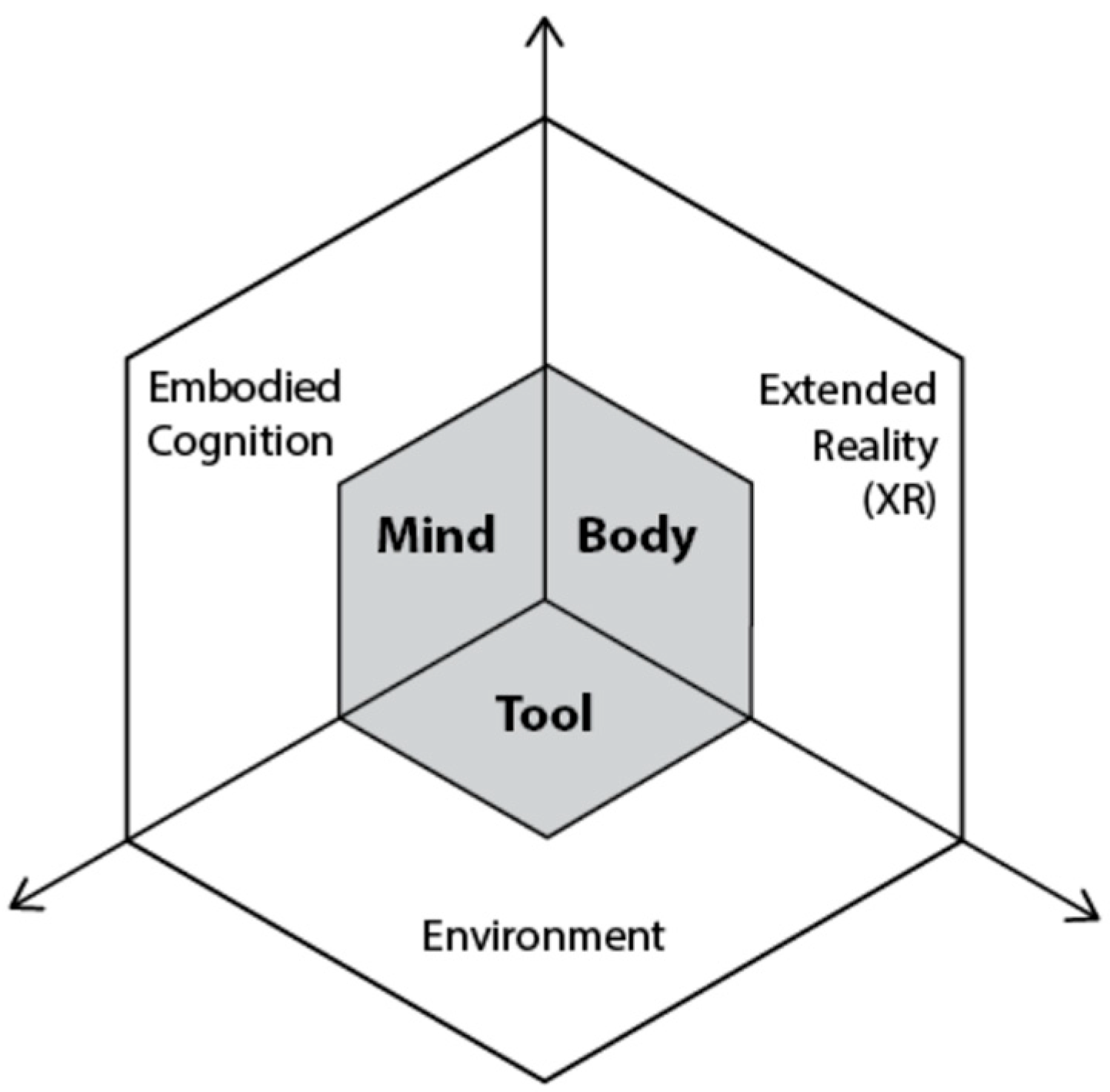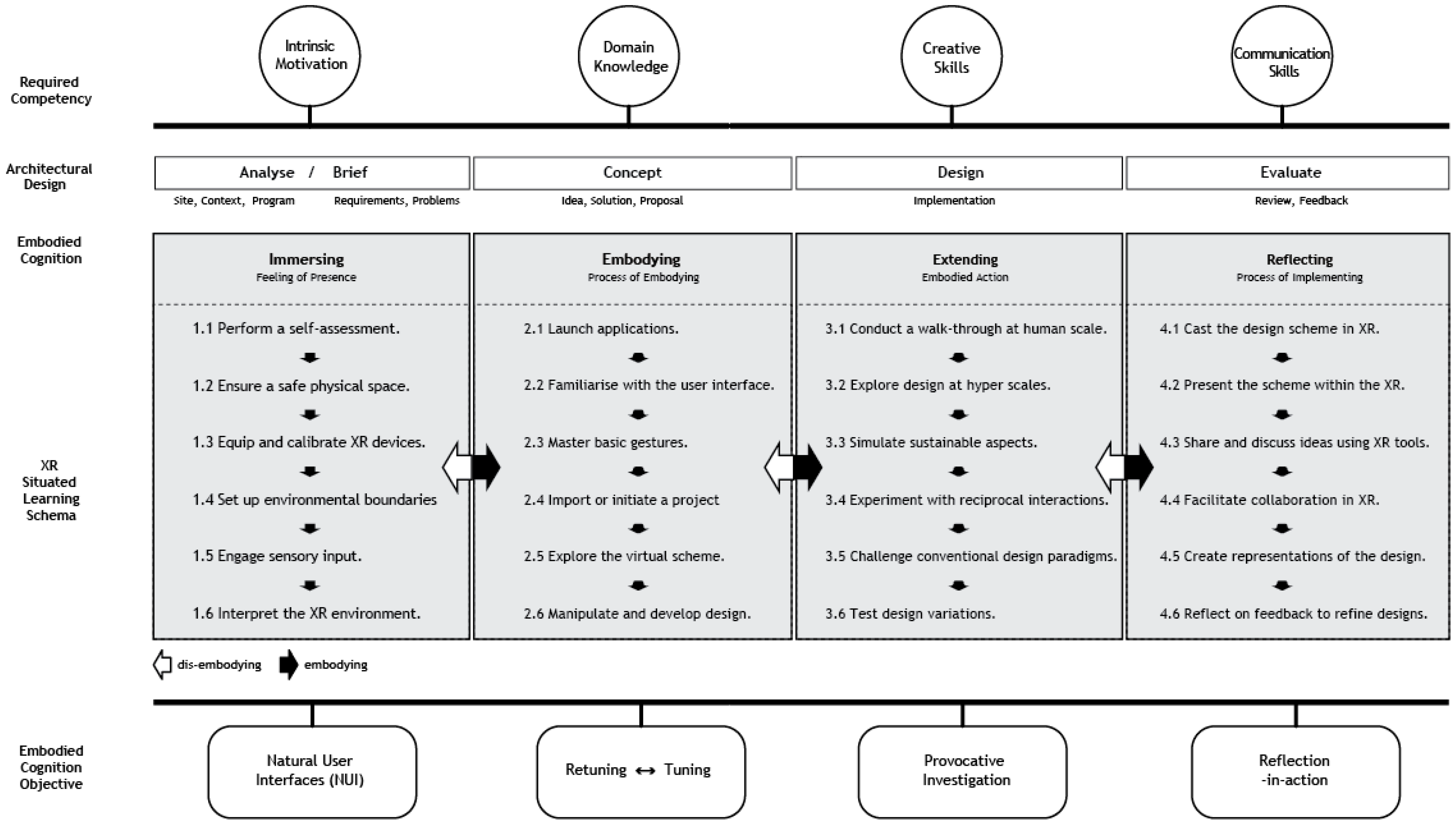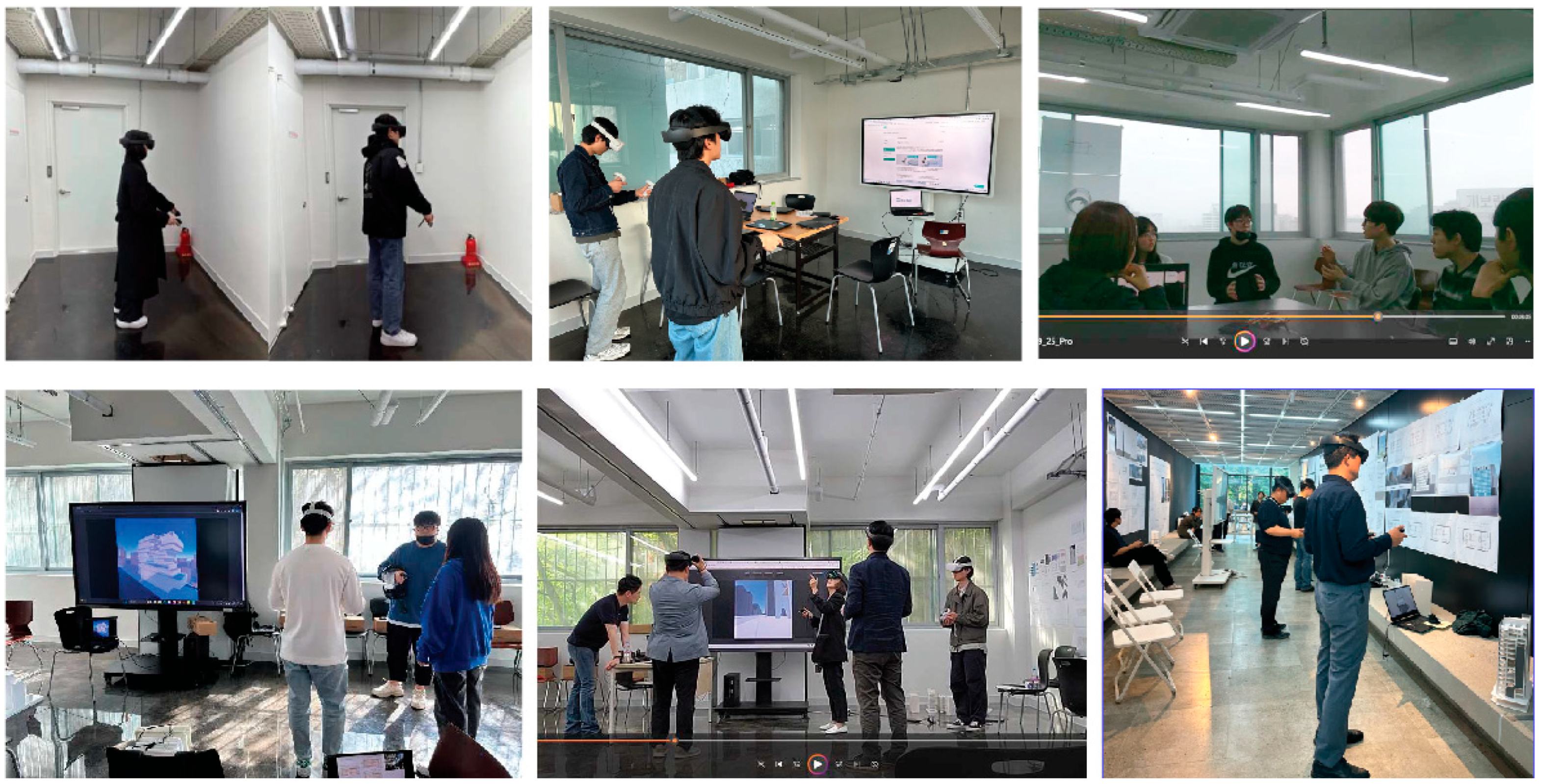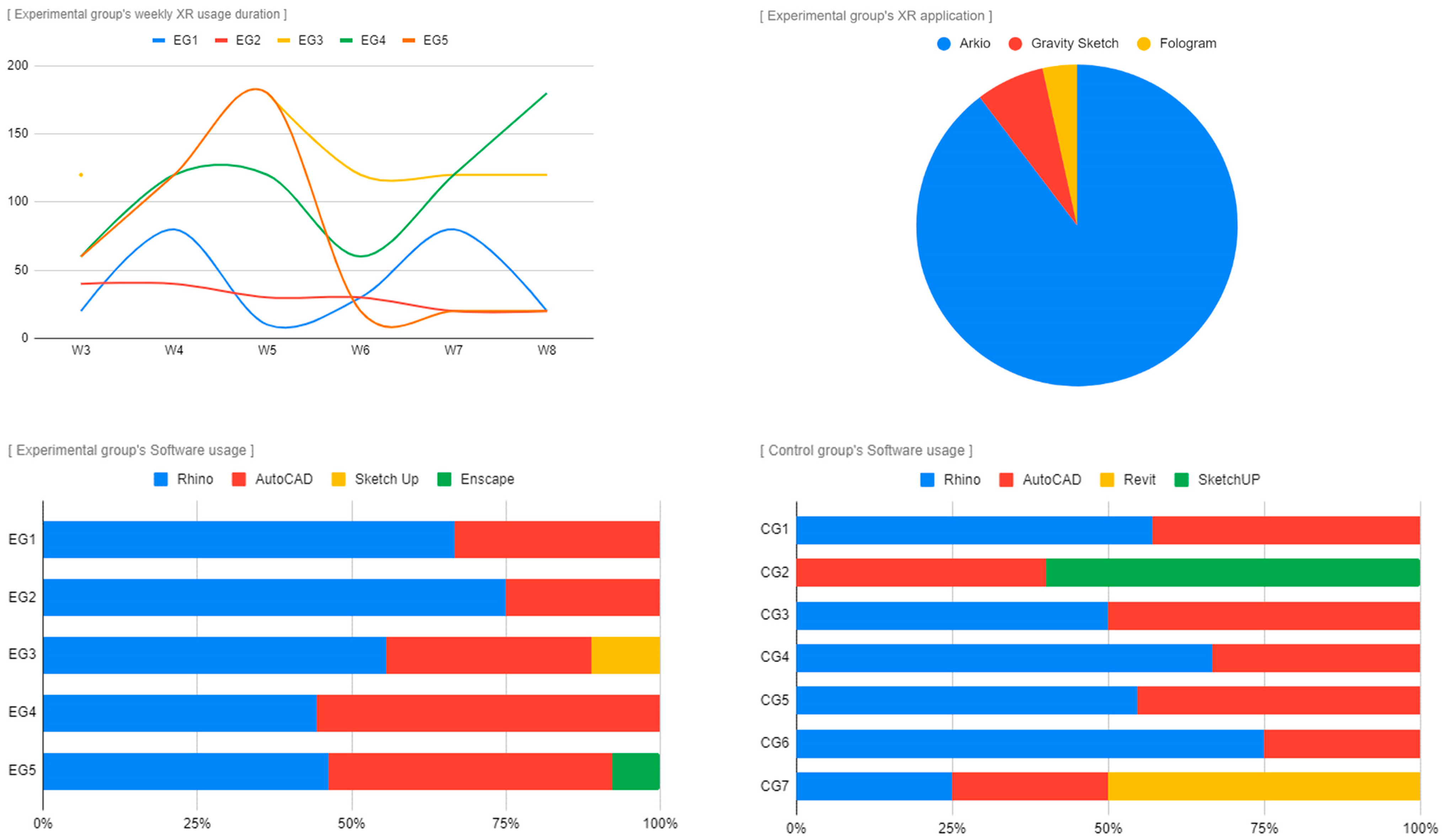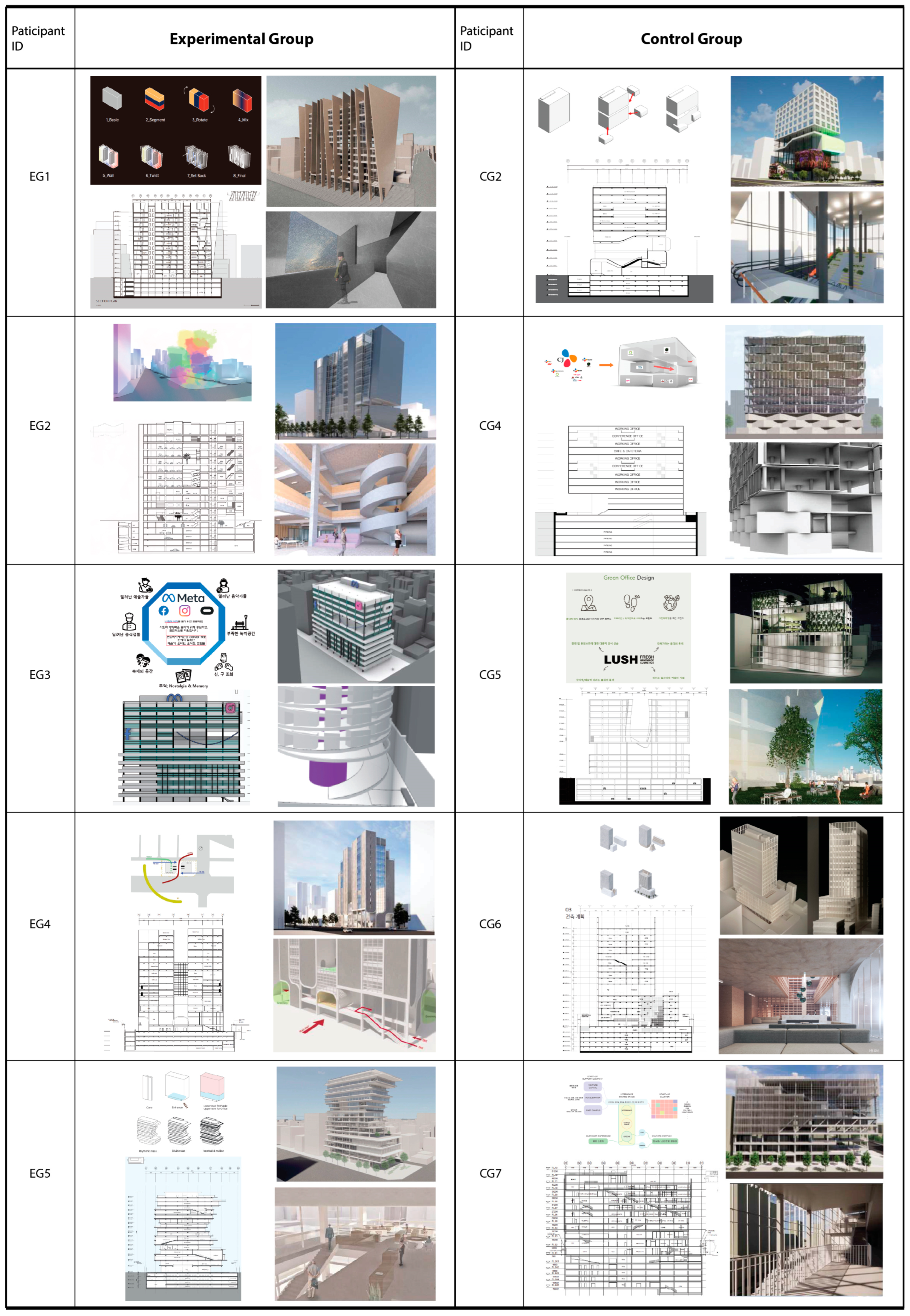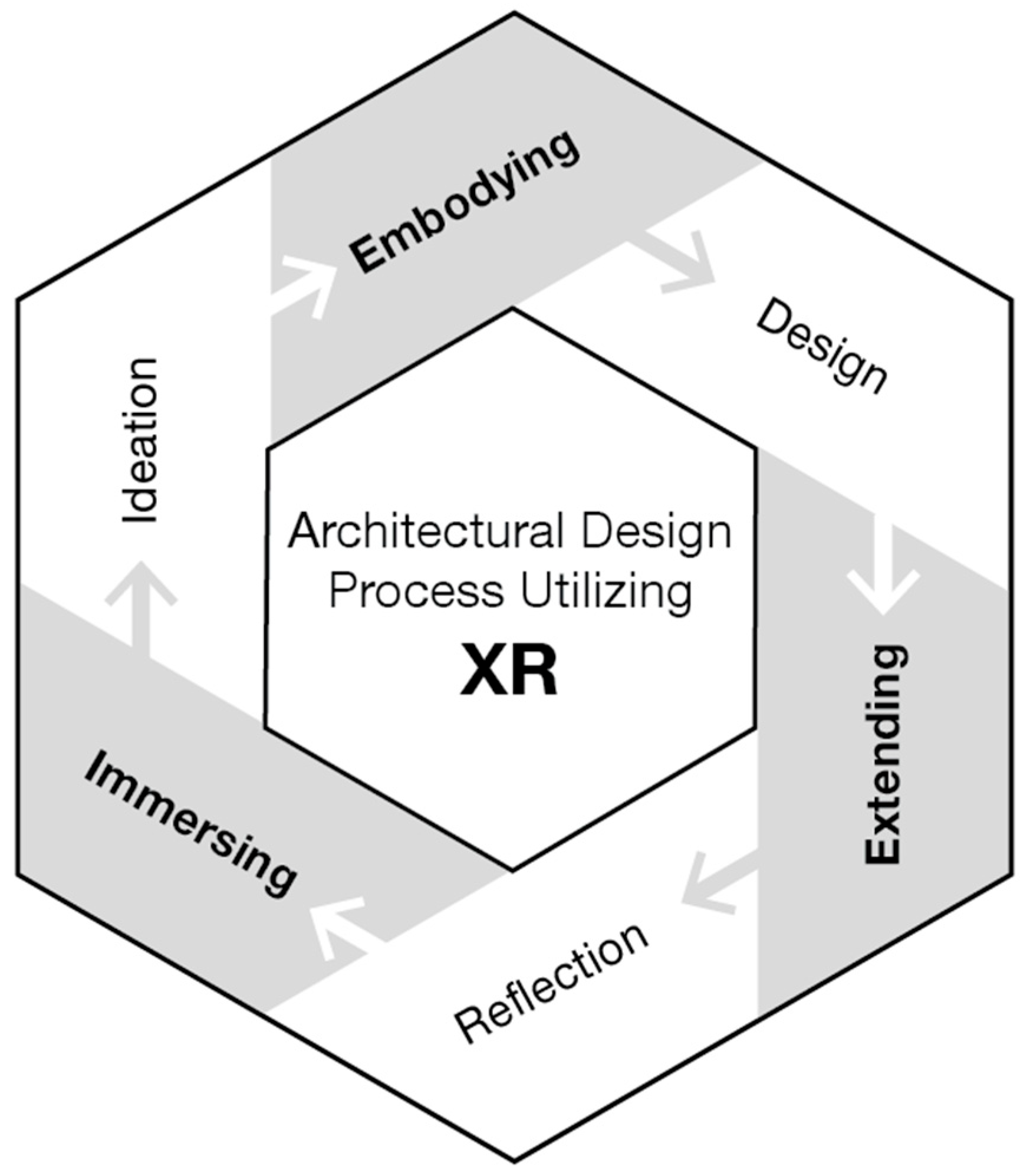1. Introduction
In today’s digital age, the ideal architect must possess strong domain knowledge, effectively utilize diverse technologies, and be open to new advancements. Modern architectural professionals have evolved from traditional architects to multidisciplinary coordinators and strategists. Studies show that architectural education is becoming more standardized and interdisciplinary [
1]. Leading universities are conducting architectural experiments and providing education on digital fabrication, material properties, design automation, and artificial intelligence (AI). For example, the Massachusetts Institute of Technology’s (MIT’s) Media Lab and the Institute for Computational Design and Construction (ICD) in Stuttgart are exploring new materials, while Harvard, Yale, and the University of Texas are focusing on AI-related research [
2].
Nevertheless, technology-related research often remains disconnected from the core of architectural design education, limiting its potential within the design process. While technological advancements have introduced diverse construction methods, they have not fundamentally transformed architectural space planning. Blikstein [
3] criticizes the superficial integration of technology in design education, emphasizing the need to go beyond mere craft skills to realize its full potential. Architectural education often differentiates between computerization—the translation of analog information into digital formats using computer-aided design (CAD) or other three-dimensional (3D) software—and computation, which leverages algorithms to generate novel forms [
4]. However, the primary focus of technology in architectural education remains representational, with students using high-performance computers to generate parametric designs, hyper-realistic 3D visualizations, and detailed technical drawings. Despite these advancements, immersive, multisensory engagement with space remains underexplored. As Merleau-Ponty [
5] asserts, spatial perception is not merely visual or conceptual but deeply rooted in embodied, multisensory experiences. This highlights the necessity of incorporating embodied cognition principles into architectural education, ensuring that students engage with design in a more interactive and experiential manner.
Extended reality (XR) includes virtual, augmented, and mixed reality, combining real and virtual environments to support multidimensional human–machine interactions. XR technology allows users to transcend physical limitations and expand their cognition as they perceive and act in virtual environments. These actions and perceptions serve as powerful educational tools, enhancing memory [
6,
7] and improving the relationship between the physical environment and educational goals [
8]. Physical interactions with digital environments facilitate deeper learning by enabling students to actively engage with abstract spatial concepts [
9] and facilitate the comprehension of 3D concepts [
10]. XR generates practical knowledge beyond traditional education, offering immersive environments that enhance engagement and reality-like experiences [
11].
Applying XR to architecture not only augments creativity but also strengthens requirement analysis, increases productivity, facilitates feasibility analysis [
12], and improves spatial abilities [
13]. XR environments encourage learners to embrace novelty and engage in interactions through behavioral, narrative, sensory, and social immersion [
14]. Architecture students can fully engage with their designs in XR, develop plans, and discuss spaces with instructors who can experience these spaces in real time within an immersive setting. In this way, movement can be understood through the body’s interaction within a specific environment. Consequently, many XR- and education-related studies have adopted an embodied cognition perspective [
15,
16,
17,
18,
19,
20]. Embodied cognition suggests that cognition is a bodily activity, with meaning emerging from the contact between the body and the world [
21]. Understanding cognition requires an understanding of the body’s structure and function as they influence cognition and decision-making processes [
22].
Despite XR’s potential in architectural education, its utilization remains limited [
23,
24]. Methodological studies aimed at enhancing XR’s effectiveness within the integrated architectural design process and examining cognitive perspectives in higher-education curricula are still lacking. Prior studies have often conflated computer-based 3D models with virtual reality, failing to distinguish between traditional 3D software and XR technologies [
25]. Additionally, existing research has frequently relied on limited technological implementations that fail to achieve the immersive, interactive capabilities that define XR-based learning environments [
26,
27] or provide limited integration into the design process [
28]. While some research has explored XR in relation to design-studio methods [
29] and student design collaboration [
30], the primary focus is to confirm XR’s educational contributions [
31]. Thus, a gap remains in the development of comprehensive educational methodologies that strategically incorporate XR technologies into curricula, maximizing their impact on design learning and spatial reasoning [
11,
18].
This highlights the necessity of incorporating embodied cognition principles into architectural education, ensuring that students engage with design in a more interactive and experiential manner.
In response to these gaps, this study aims to evaluate the educational impact of an XR-integrated architectural design studio model grounded in embodied cognition theory. The study is guided by two core research questions:
How does immersive XR-based learning affect students’ ideation, design development, and cognitive engagement in architectural education?
To what extent does embodied interaction with XR environments enhance decision-making, creativity, and spatial reasoning compared to traditional design methods?
Based on these questions, the study proposes two hypotheses: (1) that students exposed to the XR-integrated model will demonstrate improved creativity, decision-making, and reflective practices; and (2) that embodied interaction in XR enhances cognitive understanding of spatial relationships and design outcomes.
Figure 1 illustrates the XR-based pedagogy space as a multidimensional framework aligned with the study’s objectives, which focus on embodied cognition, the environment, and XR’s potential. By centering on the interconnected relationships between the body, mind, and tools, this framework aims to redefine architectural education, transforming the way students conceptualize and engage with spatial design. This interdisciplinary research combines educational technology and embodied cognition perspectives to propose a new, experiential approach to architectural pedagogy—one that leverages emerging technologies to drive a fundamental shift in design education.
2. Literature Review
2.1. Embodied Cognition and the Digital Umwelt
Gibson’s [
32,
33] ecological theory of perception has significantly influenced the concept of embodied cognition. Traditional cognitive science holds that cognitive influence is solely determined by brain function; however, new scientific approaches acknowledge that human behavior cannot be studied independently of the complex structural, natural, technological, and social environments that affect the behavioral, biological, and physiological body and its interactions with these environments. Based on this awareness, the notion that cognition involves processes beyond the brain gained traction and was broadly categorized into four key sub-concepts, known as “4E cognition” [
34]: embodied, extended, embedded, and enactive cognition. The enactive cognition theorists Francisco Varela, Evan Thompson, and Eleanor Rosch (collectively “VTR”) [
35] argue that sensorimotor capacities enable an organism to successfully interact with its environment through a perception–action loop. As an organism navigates its surroundings, this movement offers the possibility of new perceptions while eliminating old ones and revealing new opportunities for action. Thus, action influences perception, and perception shapes future actions; this perception–action loop also occurs in the body. VTR [
35] and Noë [
36] regard cognition as an embodied action, and perception as something we “do,” not something that simply occurs to or within us [
37].
From the perspective of embodied cognition, an organism is significantly influenced by its environment. Therefore, it is essential to interactively analyze the environment through human behavior to comprehend mental functions [
38]. Von Uexküll’s concepts of Umgebung and Umwelt provide a broad framework for this analysis. The former refers to the objective physical environment shared by all, whereas the latter refers to a limited, meaningful environment specific to a given organism. Living organisms inhabit this unique Umwelten. Within a shared environment, as many Umweltens can exist as there are species, and even within the same species, an individual’s postnatal experiences can lead to variations. As organisms, we belong to different worlds and live in distinct worlds [
39]. Animal structures consist of perceptive organ senses (Merknetz) and effector organs (Wirknetz). Without coordination and equilibrium between the sensory receptors and effectors, an organism cannot survive. Perceptual organs receive stimuli, whereas motor organs respond to them. This interaction forms a functional circle (Funktionskreis) that serves as a functional loop for animals and allows them to establish their distinctive Umwelt [
39].
These concepts provide valuable insights into the digital world. Devices and machinery have historically been proven useful in guiding our actions: tools, such as spectacles, telescopes, and microphones, amplify perceptions, whereas machinery and vehicles enhance effectiveness as effector tools. Using these tools, organisms perceive and interact with their environment [
39]. Digital technologies are similarly employed in two ways: perceptual tools amplify our senses, and effector tools guide our actions to achieve our goals. In the XR Umwelt (XR’s subjective environment), perceptual tools allow users to explore new layers of perception, whereas effector tools help users to manipulate targets according to their purpose. This interaction with the manipulated environment enables users to alter their perception of reality, reflect on various aspects of the physical world, or create entirely new imagined worlds. Just as different organisms experience distinct worlds based on their perceptual abilities, individual users interacting with XR environments have unique subjective experiences guided by their sensory perceptions, cognitive processes, and interactions within the digital world. Thus, the XR Umwelt can function as a constructed world that offers a subjective and unique perceptual reality. Virtual environments facilitate new experiences that allow users to manipulate and enhance their perception of space beyond a given environment [
40]. As such, the digital Umwelt can be both a subjective and an objective universe brimming with potential.
2.2. Body and Tools
Heidegger [
41] referred to transparent tools as tools that did not attract special attention during use. Similarly, Merleau-Ponty [
5] highlighted how a blind person’s cane becomes an extension of their body schema, making it an integral part of their body. From Von Uexküll’s perspective, the cane, as an embodied tool, replaces the blind person’s perceptual world (Merkwelt), functioning as both an orientation framework within their Umwelt and a tactile extension of their sensory system. Cognitive systems incorporate tools into the body schema, which is flexible and capable of continuously creating new versions, extending beyond the body’s outer boundary—the skin [
42]. Body schemas play a crucial role in tool use, and new tools can be integrated into one’s body schema [
43]. Stratton’s [
44] and Taylor’s [
45] experiments also provide strong evidence of the reconnection between the body and tools from an embodied perspective.
Smitsman [
46] argues that tools play two roles. Before use, tools are independent objects in an environment with unique affordances (opportunities or possibilities for action) that suggest new behaviors. When used, they become extensions of the user, thereby amplifying these environmental affordances. Using tools involves finding these affordances within the tool–environment relationship, with tools expanding the body and reshaping its boundaries. These insights are aligned with Gibson’s [
32,
33] perspective.
Gibson [
32] likens tool use to extending the hand or wearing clothes, noting that a cane diminishes in presence when used, functioning as an extension of the user’s arm [
47]. From a cognitive perspective, body boundaries are variable, and each individual determines their own boundaries. Tools expand the potential for perception and action, and this acquisition of new possibilities is the process of tools becoming embodied in the perception–action system. As such, tool use involves a coupling of perception and action. Ultimately, embodying is the process by which separate objects become part of the body and expand the perception–action system [
48].
Pérez-Gómez [
49] and Vesely [
50] underscore the fundamental role of bodily experience in architectural perception and design, emphasizing the necessity of engaging with the physical world. They express concerns regarding the disembodied nature of digital technologies in architectural practice, highlighting their potential detachment from the corporeal dimensions of spatial understanding. XR offers a means to mitigate these limitations by reintroducing embodiment into digital interactions, thereby facilitating immersive bodily engagement within virtual environments. By acknowledging the fluid and dynamic nature of embodied experience and critically examining its implications, XR technologies can extend cognition beyond the constraints of the physical body. This perspective not only addresses the concerns articulated by Pérez-Gómez and Vesely but also presents new pedagogical opportunities for architectural education, fostering a deeper integration of embodied cognition into design processes.
2.3. XR as a Latent Reality and Medium
Using Merleau-Ponty’s [
5] cube as an example, Noë [
36] conceptualizes perception as a function of visual potentiality, emphasizing the role of relational dynamics in perceptual experience. This relational framework is further expanded in XR environments, where users engage with objects on scale and explore them from multiple perspectives. Bergson, in his examination of material phenomena, describes them as “images” emerging from potential memories, with unrealized memories residing in a latent state. Similarly, XR embodies a realm of potentiality—an anticipated but as yet unrealized space—offering new dimensions of perceptual engagement [
51]. Gibson, drawing on Bergson’s concept of latent action, highlights the intrinsic potential within organisms’ interactions with their environment. In his discussion of the duality of information and experience, he noted that viewers might perceive false affordances until bodily movement clarifies perceptual ambiguity [
32]. If Merleau-Ponty established a phenomenological foundation for understanding perception through bodily engagement with the world, Gibson extended the theoretical boundaries of media studies through his ecological approach, further laying the epistemic groundwork for XR media. Virtual reality, as a transitional state, reinterprets embodiment as a dynamic process—a field of latent events where bodily engagement actively shapes reality [
51]. While Merleau-Ponty’s phenomenology underscores the role of the body in shaping perception within the physical world, contemporary discourse on XR suggests that immersive digital environments can extend and transform embodied experience. This phenomenon manifests in XR spaces, where users navigate virtual environments, emerge from them, and transition fluidly between settings. Unlike conventional digital representations, XR fosters a distinct mode of embodiment, wherein visual elements mirror the real world and interactive gestures blur the boundaries between the physical and the virtual. By extending bodily actions into virtual space, XR enhances action perception and expands the user’s embodied experience [
52].
While XR enhances embodied experience, its educational efficacy is contingent upon shared interaction. The absence of a co-presence in virtual environments can limit its pedagogical impact, particularly in collaborative learning contexts [
53]. Effective collaboration depends on a co-presence, where multiple participants engage in a shared spatial and cognitive experience [
18]. To address this, XR casting technologies facilitate group instruction by enabling multiple users to inhabit the same virtual space. Beyond enabling co-presence, XR transforms the role of educational media from passive content delivery to an active cognitive tool that supports learners in problem-solving and skill development [
54]. Embodied cognition theory posits that learning is deeply rooted in bodily movement and environmental interaction rather than confined to abstract mental processes alone [
55]. XR technology extends this principle by allowing learners to engage physically with digital content, surpassing the constraints of traditional learning environments [
56]. The multimodal integration of bodily perception and cognitive processing enhances memory retention and conceptual understanding as discrepancies between physical sensations and cognitive expectations create new learning pathways [
7].
Architectural education, which relies heavily on spatial cognition, stands to benefit significantly from XR’s ability to bridge the gap between perception and spatial reasoning. XR technology aids learners in recognizing discrepancies between their cognitive expectations and the realities of spatial form, a key factor in architectural skill acquisition. Moreover, XR facilitates situated learning, allowing students to employ bodily gestures and movements to interact dynamically with their virtual surroundings [
57]. Traditional architectural education often requires students to interpret two-dimensional representations to conceptualize 3D spaces—a cognitively demanding process that XR can alleviate through enhanced visuospatial immersion [
58]. By integrating constructivist learning principles, XR encourages independent problem-solving, enabling students to develop meaningful spatial knowledge through direct engagement with virtual models. This approach aligns with Dewey’s [
59] concept of “learning by doing,” wherein experiential interaction fosters deeper comprehension. By allowing students to explore and manipulate virtual architectural spaces that have yet to be physically constructed, XR not only enhances their understanding of design principles but also cultivates creativity by expanding the realm of possible spatial configurations.
In recent years, a growing number of architectural institutions have actively experimented with XR-based design methodologies. The Architectural Association’s Design Research Laboratory (AA DRL) has explored immersive design education through projects such as Virtual Bauhaus (2024), where students develop speculative environments in fully immersive settings, integrating XR with narrative design frameworks [
60]. Similarly, Bartlett School of Architecture and SCI-Arc have implemented XR in studio-based pedagogy to foster spatial experimentation, user interaction, and collaborative ideation. These institutional efforts reflect a broader pedagogical shift toward embodied and multisensory design education, supporting the claim that XR is not a peripheral tool but a foundational component of emerging architectural learning environments [
61].
In support of this pedagogical shift, the recent literature emphasizes XR’s impact on collaborative learning and interaction design. For example, Chatain et al. (2023) explore design opportunities for embodied interaction in VR, while Fortman and Quintana (2023) introduce XR as a means of fostering co-presence and collaborative cognition in virtual studio environments. These studies affirm the value of XR-based education models that integrate sensory, narrative, and social dimensions [
15,
16].
3. Methodology
3.1. XR-Based Architectural Design Studio Model
Building on theoretical foundations, the instructional model integrates architectural design stages and embodiment principles. This structured alignment offers a systematic approach to incorporating XR into architectural education. The model illustrates a structured, step-by-step approach to integrating XR into architectural design education. It emphasizes intrinsic motivation, domain knowledge, creative skills, and communication skills, aligning with traditional design phases such as analyzing context, defining design requirements, generating ideas, synthesizing proposals, implementing designs, and evaluating outcomes. Central to the model is the concept of embodied cognition, which guides students through immersive experiences in XR environments. The model also emphasizes objectives such as intuitive interaction through natural user interfaces (NUIs), adapting to XR environments, challenging conventional ideas, and iterative refinement through reflection. This model indicates the dynamic interplay of embodiment and disembodiment that occurs as learners use XR tools at each stage within the XR situational learning schema.
The framework is structured around four key stages—immersion, embodiment, extension, and reflection—to guide learners through the architectural design process within XR environments (
Figure 2).
Stage 1 (Immersion): The immersion stage focuses on creating a deep sense of presence within the virtual environment. This involves the psychological experience of “being there” [
61] and fostering active exploration from various perspectives and scales [
18]. By engaging sensory inputs, such as vision, sound, and touch, learners establish their presence and navigate the XR environment. The depth of immersion plays a pivotal role in enhancing the educational impact by promoting active engagement.
Stage 2 (Embodiment): In the embodiment stage, learners acclimate to the XR environment and develop mastery over its tools. This involves creating, manipulating, and modifying 3D objects, thus fostering hands-on engagement [
62]. Unlike traditional settings, XR environments allow unrestricted exploration and dynamic alteration of virtual surroundings, encouraging creativity and deeper involvement in the design process.
Stage 3 (Extension): The extension stage enables learners to overcome real-world limitations by exploring designs from diverse perspectives. Building on Hirose’s [
48] concept of tools as perceptual amplifiers—enhancing sensory input and revealing previously inaccessible layers of reality—XR technologies further extend this capability by immersing users in interactive, multidimensional environments. This stage encourages learners to manipulate virtual spaces, challenge conventional design norms, and gain new insights into their work.
Stage 4 (Reflection): Reflection involves iterative evaluation, presentation, and refinement of designs. This stage emphasizes critical thinking and constructive feedback, aligning with Schön’s [
63] concept of “reflection-in-action.” Learners engage in continuous improvement by revisiting and refining their designs based on feedback and collaborative discussions.
These four stages form a structured XR-based architectural design studio model, supported by a situated learning schema. Each stage comprises six sub-procedures, totaling 24 steps that systematically guide learners through cognitive development and spatial design exploration.
At each stage, students are expected to develop four embodied cognitive competencies essential for XR-based architectural learning. During Stage 1 (Immersion), students become proficient in using NUI within XR environments, allowing intuitive interaction with digital spaces. In Stage 2 (Embodiment), they engage in a tuning and retuning process, continuously adjusting their perception and control as they shift between embodying and disembodying tools in virtual design workflows. Throughout Stage 3 (Extension), the model encourages provocative investigation, prompting students to challenge conventional design norms and explore alternative spatial possibilities. In Stage 4 (Reflection), reflection-in-action plays a crucial role, enabling learners to iteratively refine their designs through critical assessment and real-time adjustments. Together, these cognitive objectives ensure that students effectively integrate XR technologies into architectural design.
3.2. Procedure and Methods
This study employed an action research methodology, carried out over two iterative phases. The first phase (weeks 1–8) examined the impact of XR on time management, decision-making, and students’ sense of ownership in the design process. The second phase (weeks 9–15) assessed design quality, creativity, presentation skills, and overall student satisfaction.
Participants were divided into experimental and control groups based on results from the Simulator Sickness Questionnaire (SSQ), which measured spatial perception and sensitivity to virtual environments. Five students were assigned to the experimental group and participated in the XR-integrated design studio curriculum. The remaining students formed the control group and followed a traditional studio format. Each XR student received an Oculus Quest 2 headset and was trained to use applications such as Arkio and Gravity Sketch. Instruction was provided on incorporating XR into their design workflow in accordance with the proposed studio model. Although both groups shared an open studio space, a designated area was reserved for XR activities to ensure safety and minimize cross-exposure. Students in both groups developed their design projects weekly, receiving individualized critiques to guide iterative refinement.
The study involved two teaching experts, three advisory panel members, and twelve third-year architecture students. Weekly four-hour tutorials were led by the author and a co-instructor, while the advisory panel—comprising two experienced architects and one digital architecture specialist—provided feedback on student work and contributed to the model’s development. Ethical approval was obtained from the Institutional Review Board (IRB), and all participants provided informed consent.
The study was conducted as part of the Architectural Design Studio-5 course, delivered in the spring semester at H University. The studio theme, “BACK TO OFFICE: Returning to the Office,” asked students to reimagine office environments in response to post-pandemic shifts in work culture. Projects involved the design of mid- to high-rise towers (9–15 stories), incorporating urban site analysis, program development, and strategic spatial planning grounded in behavioral, technological, and environmental considerations.
Data were collected through a multi-method approach, including weekly surveys, observations, audio/video recordings, and focus group interviews (FGIs). Twelve weekly surveys were administered to both groups, supplemented by post-review surveys for targeted feedback. Observational logs, photos, and video documentation captured a wide range of classroom activities and interactions. The author, also serving as the instructor for the experimental group, recorded detailed field notes throughout the course. After each design review, FGIs were conducted to gather reflective feedback from students, capturing both verbal and non-verbal responses. Two additional FGIs were held with the co-instructor and advisory panel to evaluate the XR tools and applications used in the studio. These interviews provided qualitative insights into pedagogical outcomes and technological integration.
To assess the effectiveness of the XR-based model, student outcomes were evaluated using four core criteria developed in consultation with the advisory panel: design quality, creativity, presentation skills, and self-satisfaction.
Design quality was assessed based on the coherence of spatial organization, contextual integration, programmatic resolution, and formal articulation. Reviewers examined how well the design addressed the brief and responded to site-specific challenges.
Creativity was evaluated by the originality of the concept, inventiveness of spatial solutions, and the students’ ability to challenge conventional approaches. Special attention was given to how XR tools influenced spatial experimentation.
Presentation skills encompassed both verbal articulation and visual communication, including clarity of diagrams, drawings, and immersive walkthroughs. Jurors assessed how effectively students used XR to guide them through virtual spaces.
Self-satisfaction was measured through structured post-review surveys and FGIs, reflecting students’ sense of growth, ownership, and confidence in their design process.
Each criterion was analyzed using a combination of student work, teaching logs, interview transcripts, and peer/instructor feedback. This multi-source approach ensured data triangulation and enhanced the reliability of the qualitative findings.
Figure 3 presents a sample of the survey questionnaire, while
Figure 4 shows excerpts from audio transcripts of the experimental group’s FGIs.
Figure 5 visually documents the data collection process, including photos and video stills of students participating in SSQ tests, tutorials, design reviews, and interviews. The data were analyzed using ATLAS.ti (version 23.3.4), which supported systematic coding and thematic interpretation. This longitudinal analysis allowed for the identification of patterns and insights into the XR-integrated model’s impact on student learning and engagement.
4. Results
4.1. Stages 1 and 2
In Stages 1 and 2, the technology usage patterns of the experimental and control groups were compared and students’ perceptions of XR and their approaches to solving design problems were analyzed.
Figure 6 shows the survey results.
Table 1 provides a structured example of the thematic analysis, detailing weekly XR utilization purposes, specific use cases, and the categorization of embodied cognition types observed in the experimental group’s activities. Additionally,
Table 2 presents an analysis framework featuring 52 open codes extracted from the transcriptions of the FGI recordings, systematically categorized by themes.
4.1.1. Patterns of Technology Usage
During Stages 1 and 2, the duration of XR use varied significantly within the experimental group. On average, students engaged with the XR devices 1.6 times per week, with sessions lasting approximately 42.3 min; however, individual usage fluctuated, particularly during the review period. The primary purpose of XR is massing design, which includes modifications, spatial experiences at the human scale, and the verification of entry and core circulation paths. Three students used XR effectively, which positively impacted their designs, whereas two students made less effective use of XR—their contributions being similar to those using conventional 3D software—without clear objectives. The baseline analysis of architectural design software use revealed no significant differences between the experimental and control groups, who both primarily used Rhino, SketchUp, and AutoCAD.
4.1.2. Participants’ Perceptions of XR Usage
Participants’ perceptions of XR in the design process were assessed through weekly and post-review surveys and FGIs. Both groups acknowledged XR’s impact on architectural design. While only the experimental group actively used XR, the shared studio environment facilitated peer communication, allowing the control group to observe its influence on spatial perception and design development. The experimental group found XR particularly effective in translating conceptualized spaces into real-world experiences. Weekly surveys showed that repeated XR exposure enhanced spatial awareness, bridging the gap between computer-based and real world perception. XR also enabled objective design evaluation from both designer and user perspectives, fostering deeper design comprehension.
XR tutorials (
Figure 7) further supported collaborative problem-solving between tutors and students. Using XR headsets, the tutors and students accessed and navigated student designs in a shared virtual environment, discussing architectural elements at various scales in real time. This immersive feedback process allowed students to refine their projects with greater precision and spatial understanding.
4.1.3. Design Problem-Solving Patterns
Distinct patterns in problem-solving approaches emerged between the experimental and control groups. The experimental group actively engaged in practical design challenges, efficiently identifying and addressing spatial and structural issues. In contrast, the control group remained focused on conceptual concerns, often struggling to develop concrete solutions. Within the XR environment, the experimental group demonstrated greater flexibility and efficiency, rapidly resolving design problems and exploring diverse spatial configurations. By comparison, the control group exhibited limited variation, frequently producing box-shaped spaces that lacked creativity and confidence. Individual design analysis further highlighted the experimental group’s superior decision-making and time management, indicating that XR integration fosters a more dynamic design process that enhances innovation and practical problem-solving.
4.1.4. Reflections on Stages 1 and 2
The findings indicate that learners responded positively to the XR-embodied design process, demonstrating greater engagement and proactive problem-solving compared to conventional design methods. While most students in the experimental group were receptive to new technologies, some found it more difficult to master new applications and tools. Although they initially preferred XR, its usage declined as the design process advanced, with students reverting to two-dimensional (2D) software, such as AutoCAD, to meet mid-term review requirements, including plans, sections, and elevation drawings. This trend highlights the need for strategies that seamlessly integrate XR with conventional design workflows to ensure its benefits persist throughout the entire design process. Reflections on Stages 1 and 2 emphasized the necessity of refining the XR-based studio model to provide more structured support while maintaining XR’s advantages and addressing adaptation challenges.
4.2. Stages 3 and 4
In Stages 3 and 4, students’ patterns of technology usage and their perceptions were examined from the design-development phase to project completion. A comparative analysis was conducted to investigate the design-improvement strategies employed by the experimental and control groups and the significance of their final outputs.
4.2.1. Patterns of Technology Usage
On average, participants in the experimental group used XR devices 1.6 times per week, with each session lasting 34.4 min, reflecting an 8 min decrease from Stages 1 and 2. Usage patterns remained consistent among students, except for one outlier (participant code EG3). Overall, a continuous decline in weekly XR usage was observed. The primary applications of XR included design refinement and verification, such as reviewing building designs, experiencing internal spaces at a human scale, conducting walkthroughs of lower ground and entrance zones to assess circulation paths, and designing facades. Despite XR integration, there were no significant differences in baseline technology usage between the experimental and control groups, as both continued to rely on drafting and 3D rendering software for their final outputs.
4.2.2. Participants’ Perceptions of XR Usage
An analysis of weekly and post-review surveys and FGIs revealed that both groups acknowledged XR’s transformative impact on the design process. Students and tutors agreed on its significant influence, emphasizing its ability to enhance the design experience and support informed decision-making. The experimental group particularly valued XR for its role in understanding spatial relationships at a real scale, effectively bridging the gap between computer-based representations and real-world experiences. Tutors and expert panels further affirmed XR’s substantial impact on architectural design processes and outcomes, underscoring its potential as a powerful tool in architectural practice. These findings suggest that integrating XR into architectural design studios is widely perceived as beneficial by both students and advisory panels. Its adoption holds the potential to transform architectural education, reshaping how architects approach design challenges and develop innovative solutions.
4.2.3. Utilization of XR and Architectural Design Strategies
Varied XR-utilization patterns were observed among the experimental group in Stages 3 and 4, aligning with the findings from Stages 1 and 2. Students in the experimental group effectively integrated XR into their design process, using it to overcome design stagnation and explore a broader range of alternatives. In contrast, the majority of the control-group participants struggled to progress beyond their initial concepts, resulting in minimal variation in their final designs.
Conducted in the latter half of the 15-week course, Stages 3 and 4 focused on design iteration and further development. The final outcomes were evaluated through a qualitative assessment based on multiple data sources, including students’ drawings, tutors’ teaching logs, participant observations, and expert-panel feedback. Evaluation was conducted using four key criteria: design quality, presentation skills, creativity, and self-satisfaction. The assessment results revealed notable differences between the groups. The experimental group consistently outperformed the control group in design quality, creativity, and self-satisfaction. While oral presentation skills were comparable, the experimental group demonstrated superior visual communication.
Final evaluation scores ranged from A+ to C+, with the control group averaging 3.0 and the experimental group 3.8 on a 5-point scale. However, it would be premature to attribute these superior outcomes exclusively to XR usage, since multiple factors—including pre-existing skills, instructional methods, and the degree of XR integration—likely contributed to these differences.
Figure 8 presents the student outcomes, showcasing work from five students per group, as one control-group student withdrew before the first review and another failed to meet final requirements, reducing the total number of participants from 12 to 10.
4.2.4. Reflections on Stages 3 and 4
Reflections on the later stages considered three key aspects: the architectural design studio model, studio operation, and design outcomes. From a model perspective, XR proved effective in mitigating design-process stagnation and enhancing the quality of final design outcomes. The experimental group leveraged XR to develop innovative solutions, integrating physical experiences into problem-solving; however, the effective integration of XR requires strategic adjustments, particularly in the early design stages. To optimize curriculum adaptations, XR-based deliverables should be prioritized, encouraging students to present designs within the XR environment. Techniques such as cutting through virtual models during reviews or allowing reviewers to experience spaces interactively provide a more effective means of conveying design intent than traditional deliverables.
Furthermore, incorporating building information modeling (BIM) into the workflow could streamline design development, minimizing reliance on 2D drawings and enabling seamless XR integration. This approach would allow students to focus on exploration and refinement, fostering a more efficient and innovative design process.
5. Discussion
This study explores the integration of XR in architectural education, focusing on its role in enhancing ideation, design development, and reflective practices. The findings reveal both XR’s transformative potential and the challenges associated with its adoption. This section critically reflects on the observed patterns of use, contextualizes XR’s pedagogical implications, and presents strategic recommendations for its meaningful integration.
The XR-based architectural design studio model (
Figure 9) was highly effective in the early stage ideation, enabling students to transition from abstract concepts to tangible design solutions. By immersing users in virtual spaces, XR fosters an embodied design process that integrates cognitive and sensory experiences, enhancing spatial awareness and enabling real-time iteration. Compared with traditional 2D and 3D design tools, XR offered a dynamic medium for rapid prototyping and site-specific exploration, helping students bridge the cognitive gap inherent in abstraction-heavy workflows.
In response to the first research question—how immersive XR-based learning affects students’ ideation, design development, and cognitive engagement—the findings indicate that XR significantly improved early-stage exploration, design iteration, and engagement with spatial problems. This supports Hypothesis 1, which proposed that XR would enhance creativity, decision-making, and reflective practices. Likewise, the second research question—whether embodied interaction in XR environments improves spatial reasoning—was affirmed through students’ improved ability to evaluate design alternatives at full scale and adjust their decisions accordingly. These outcomes provide empirical support for Hypothesis 2 and confirm that XR-integrated learning environments foster deeper cognitive understanding of spatial relationships and design intent.
XR’s pedagogical relevance extends beyond architectural design studios. Its immersive affordances can be applied to urban design and interior architecture studios, where spatial feedback and user-centric simulation are crucial. For instance, XR can enhance public space planning and interior detail coordination through real-time walkthroughs and spatial interaction. These practice-oriented applications suggest that XR is not only a conceptual tool but also a valuable medium for experiential and technical design tasks.
The study also highlights how bodystorming within XR environments enhanced creative problem-solving. Students engaged directly with spatial challenges from a user-centered perspective, developing iterative and responsive design strategies. However, adoption patterns varied—while some students fully embraced XR tools, others reverted to conventional methods due to initial unfamiliarity or perceived complexity. To address this, structured XR tutorials and scaffolded design tasks should be introduced early in the curriculum to build student confidence and promote equitable engagement.
Beyond ideation, XR facilitated iterative refinement by improving spatial evaluation, decision-making, and problem-solving. The experimental group consistently demonstrated stronger proficiency in addressing design challenges such as circulation, proportion, and envelope articulation, owing to XR’s ability to simulate design intent at a 1:1 scale. However, a recurring limitation emerged in the transition to detailed design phases: students frequently reverted to 2D software to meet conventional deliverable formats such as plans and sections. To overcome this discontinuity, it is recommended that BIM-compatible workflows and plugin-based integrations be embedded into the XR curriculum. Tools like BIMxplore, which interface with Revit, and plugins that enable real-time transfer from Rhino or SketchUp to XR platforms allow students to carry conceptual models forward without redundant modeling efforts. Embedding these tools within the educational pipeline could reposition XR from a peripheral visualization aid to a central medium supporting both conceptual and technical development.
XR also proved to be a powerful medium for reflection and critique. Its immersive and interactive qualities enabled students and reviewers to engage with design proposals more comprehensively than traditional presentation formats. Expert panels and instructors acknowledged that XR enhanced design communication and facilitated more informed, spatially grounded feedback. However, the study also revealed a learning curve among students with limited digital experience, underscoring the importance of targeted instructional support and stepwise tool integration. From a pedagogical standpoint, XR redefines the relationship between learners, tools, and environments, extending the boundaries of conventional studio practices. This expanded ecological framework emphasizes the cyclical interplay of perception, action, and reflection, where XR tools enable continuous feedback between thinking and making. To fully leverage these affordances, however, curricular redesign is needed to strategically align XR tools with design tasks and educational outcomes.
In addition to pedagogical alignment, practical barriers to XR adoption must be addressed. Access to high-performance XR devices and software varies widely across institutions, and the cost of equipment, licensing, and maintenance may constrain scalability. Technical infrastructure, dedicated workspace, and instructor training also require institutional investment. Addressing these operational challenges is essential to ensure equitable access and the long-term sustainability of XR-enhanced education.
To fully harness XR’s potential in architectural education, the following strategies are recommended:
Curriculum Adaptation: Integrate XR-based deliverables, such as virtual walkthroughs and interactive design reviews, into key milestones to sustain engagement and foster skill development.
Pedagogical Frameworks: Emphasize embodied cognition strategies that guide learners in using XR for ideation, design, and reflection, ensuring effective engagement.
Collaborative Platforms: Introduce multi-user XR environments to support team-based design sessions, encourage diverse perspectives, and enhance peer feedback.
Ongoing Support: Provide comprehensive training and resources to address technical and cognitive challenges, ensuring equitable access and maximizing XR’s benefits.
6. Conclusions
This study proposed and tested an XR-based architectural design studio model grounded in the theory of embodied cognition. By embedding immersive learning into the design process, the model encouraged students to engage spatially, cognitively, and physically with their work. The findings indicate that XR significantly enhances design ideation, problem-solving, and spatial reasoning, particularly in the early stages of architectural development.
However, the limited continuity of XR use into the later stages of design highlights the need for more integrated workflows. As students often revert to traditional tools for documentation, the full potential of XR as a continuous design medium remains underutilized. Addressing this limitation will require the adoption of XR-to-BIM workflows and plugin-based solutions that connect widely used tools like Rhino, SketchUp, and Revit within XR environments. These integrations can reduce redundancy and support sustained XR engagement across all phases of design education.
From a pedagogical standpoint, XR extends the learning environment into a digital Umwelt—one that supports embodied interaction, iterative feedback, and critical reflection. To fully realize XR’s educational value, architectural curricula must evolve, embedding XR as a standard component rather than a supplemental experience. This includes developing collaborative XR platforms, integrating AI-supported analysis tools, and refining assessment methods aligned with immersive outputs.
As the demands of the Fourth Industrial Revolution reshape architectural education, integrating XR with emerging technologies, such as AI, will be pivotal. In fact, students already use tools like Midjourney or DALL·E to generate conceptual images, which they later interpret spatially in XR platforms. This emergent practice demonstrates the natural synergy between generative AI and immersive spatial modeling. Additionally, large language models (LLMs) could support scenario-based storytelling or site narratives within XR workflows—opening new pedagogical avenues for cross-modal learning and automated design support. To move from conceptual potential to practical application, future educational models should explore the use of AI-powered design assistants, adaptive XR learning environments, and real-time feedback systems that respond to student progress and spatial decisions. Such integrations could enhance student autonomy, support iterative reasoning, and simulate design scenarios dynamically within immersive contexts.
Future research will expand the model by integrating BIM-based XR workflows to support later design stages, including detailing and construction logic. By doing so, XR can be positioned not only as an effective educational tool but also as a bridge to professional design practices in an increasingly hybridized and technology-driven industry.
